SIMIANE-LA-ROTONDE & A BEAUTIFUL GARDEN – LITTLE-KNOWN GEMS IN HAUTE PROVENCE
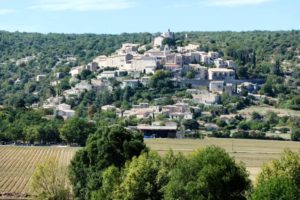
We tend to think that there’s not many undiscovered places left in Provence these days. However, there are interesting little corners of the region that still remain relatively untouched and almost devoid of visitors. Simiane-la-Rotonde is one such place: clinging to a small hill on a high plateau to the northeast of Apt and the Luberon, with groves of pines and cypresses rising up the slopes. One of its great joys is that in June and July, the surrounding fields explode in a profusion of lavender, the emblematic plant whose flower is the colour of Provence. What took us there though, aside from the lavender, was to find out about the ’Rotonde’ for which the village is named.

Surrounded by olive groves and the famous lavender fields, Simiane-la-Rotonde is in an enviable location in the Alpes-de-Haute-Provence at an altitude of 630m. above sea level, it has remained practically unchanged for centuries. A typical Provençal village perché (hilltop village) it borders the Vaucluse, with the mountains of the Luberon to the south-west, Forcalquier to the west, and close to Mont Ventoux. As its name would suggest, a perched village is typically nestled on the side of a hillside, often fortified, and built just below a château. The little town is so charming that it is now listed as a cité de caractère (city of character).
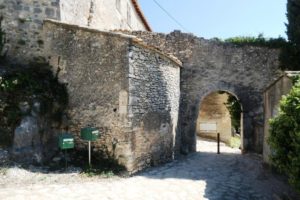
There is a permanent population of around 600 residents, and the inhabitants are known as Simianais. As the village is car-free, you have to park your car at the top of the entrance to the village and walk down the cobblestone streets from there. Exploring the village, you pass along narrow streets lined with tall stone houses that typically date from the 17th – early 18th centuries, while enjoying the colours and scents from the numerous flowers such as irises and roses.
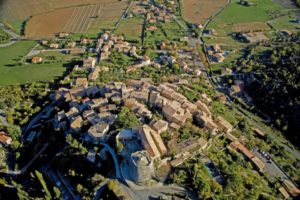
The village developed in the Middle Ages around the château, whose enclosure extended to the ramparts below. During the Renaissance the village became prosperous due to the development of a local glass industry that made Simiane’s reputation when its products were exported throughout Provence—it’s thought that the locals probably learnt glass-making skills from the monks at the nearby Abbaye de Valsaintes. As a result of this wealth, on the upper reaches of the village there are a number of grander-styled houses featuring fine architectural details, such as ornate doorways and arches.
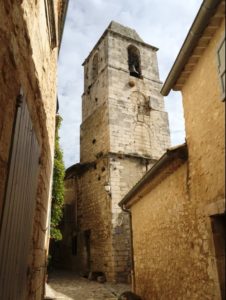
As you make your way down the sloping streets there’s a church campanile that you will see, and a 16th century bell-tower from the Église Saint Jean—although the church itself no longer exists; the small Église Saint-Pierre, with an impressive interior, somewhat unexpected, given the simple exterior; and the 16th century covered market hall that was being used as additional space for a small café opposite, set out with tables and chairs, where we had a very pleasant light lunch. As a bonus, there’s a stunning view across the plains below the village from the market hall.
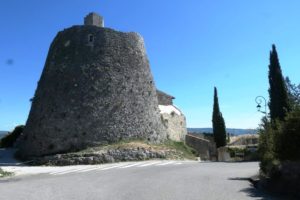
Simiane-la-Rotonde is steeped in history and has remained largely unchanged for many centuries. The highlight, that also gives the village its name, is the medieval Château des Agoult with its dramatic rotunda, at the top of the village, in front of the carpark.
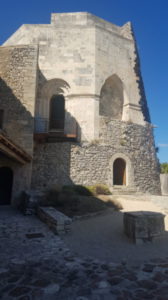
The château’s history goes back over 1,000 years, to a building which succeeded an old Roman oppidum (fortified town). Owned by the Agoult-Simiane family, powerful vassals of the Counts of Provence. From the 12th century on, they built about 50 châteaux over a huge territory, of which the one built at Simiane is the oldest. It underwent several major changes during periods alternating between intense activity or partial abandonment. From 1031, it had already appeared as a castrum, (castle or château), and records show that it was donated to the Abbey of St Victor in Marseilles. The oldest part of the château, dating to the early Middle Ages, is the cone-shaped hexagonal rotunda, the old keep, over 18m high, that was once surrounded by a wide, dry moat.
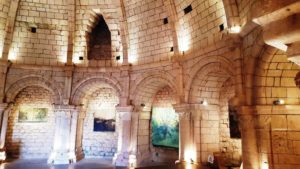
The entrance to the château also serves as the tourist information centre for the village. The main part remaining is the massive rotunda, which has an unusual multi-faceted design, while inside is a vast hall with a magnificent stone domed roof, whose ribs form a slightly irregular 12 sides, meeting at the top around a central oculus.
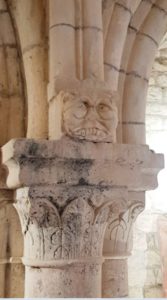
The ribs rest on a series of arches below with ornately carved stone capitals some depicting strange human masks, sometimes grotesque or bestial. A most impressive achievement for the 11th century, and one of the most unusual buildings in Provençal medieval military and civil architecture. The main lodge building is still there as well as the defensive walls.
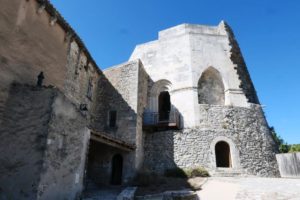
The château was abandoned by the Agoult family from the 17th century onwards, and as time went on it deteriorated, and some parts were used for agricultural purposes. In 1803 it was sold to a carpenter who sold the Rotunda to the local departement. It has been classified as a Monument Historique since 1841 and saved from ruin by several restoration and renovation campaigns. It was opened to the public in 1986.

The rest of the château was bought by the Commune (municipality) in 1999, and has been the subject of an ambitious restoration program. This investment, quite considerable for a municipality of this size, is justified by the historical and architectural value of the site. There is a breath-taking view of the roofs below and the valley spread out beyond, from the terrace built on the remains of a 11th century building.
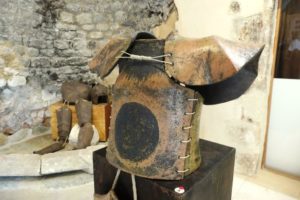
The rotunda is the venue for exhibitions by contemporary local artists; a fine display about the history of the village including documents and archaeological finds in a beautiful Romanesque room; and hosts an international early music festival, “Les Riches Heures Musicales de la Rotonde”, every summer in early August. The village also has a Medieval Festival in the first weekend of July. However, the local economy remains essentially agricultural from the fields of fine lavender below the village that grows between 800 and 1,200 m. above sea level. To see lavender in bloom, generally it’s roughly from mid-June to late July, and in the upper reaches of the Haute Provence, even into early August, depending on the weather.

Simiane-la-Rotonde is home to the largest lavender and lavandin co-operative in France. We found out that there are more than 150 species of lavender in the world. Two of them are mainly cultivated in Provence: fine lavender and lavandin. Fine, or true lavender, is found in the areas at the highest altitude. It represents 10% of the cultivated surfaces and is characterised by its small size and a stem composed of a single spike. This quality is mainly used in perfumery, aromatherapy and medicinal purposes. One hectare of fine lavender produces about 15kg of essential oil.
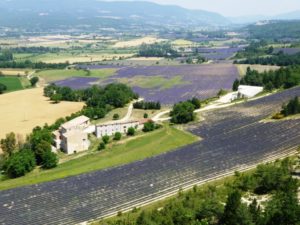
Lavender’s powerful perfume hides an unsuspected fragility. For several years, producers have been facing many challenges to maintain a profitable and quality production in the Haute Provence region in order to sustain their official designation for organic certification. Climate change, combined with the presence of a parasite, is a long-term threat to the cultivation of lavender in its original habitat, and to the maintenance of the characteristic landscapes of Provence. As matter of some urgency, scientists are developing a variety of techniques to protect the plantations.

Local growers welcome visitors who are captivated by the dazzling sight of fields of lavender as well as the sensual pleasure of its perfume. Good maps, notably Les Routes Lavande, available from the various local tourist bureaux, set out suggested routes to help visitors experience the best and mark which producers and lavender distilleries are open for visitors, including a number of accommodation options. However, this increase in lavender tourism is also something of a mixed blessing for the farmers, as many people aren’t content with admiring from the road, but proceed without a thought to tramp through the crops for a more “immersive” experience. Farmers are increasingly having to remind visitors that this is their livelihood and request that they leave as minimum a trace of their visit as possible!

Visiting what remains of the château at Simiane-la-Rotonde, you’ll see two rooms on the east wing, formerly the “Saint-Victoire Laboratory”, are devoted to aromatic and medicinal plants, information about the distillation, properties and uses of essential oils. The courtyard of the château is made up of small gardens created with plans from the nearby Abbaye de Valsaintes, designed to show the visitor the diversity of the local botanical terroir.
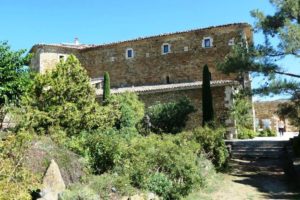
Now referred to as the Abbey Garden Valsaintes, it sits on a rocky promontory 5 km S.E. of Simiane-la-Rotonde. Garden events such as lectures and talks, learning about planting and cultivating roses, planting botanical bulbs, planting in the colder months, are held throughout the year. As well, the Abbey is also a yoga retreat offering a variety of yoga-related courses and classes. From mid-May to early June, the gardens of the Abbey are said to be at their peak, with over 550 varieties of roses in full flower.

The Abbaye de Valsaintes was built on a site dating back to Paleolithic times, from which various materials have been discovered along with the remains of a Gallo-Roman structure, a medieval castrum and an ancient Celtic sanctuary dedicated to the sun god Bélénos. Notre-Dame de Valsaintes was founded by the Morimonds, an affiliated Cistercian Order, around 1180, with 12 monks who set about cultivating the land and maintaining the surrounding woods, alongside their glassmaking activities, which spread up to nearby Simiane-la-Rotonde.
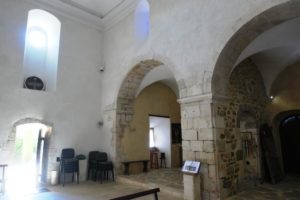
Not much of the original 12th century Cistercian abbey remains. The existing church dates from around 1660, where Gregorian chants are regularly performed by Jean-Louis Moine. He also discusses the history and meaning of these chants to the monks of the abbey, who lived there until the Revolution.

Since the Revolution, the buildings had been used as a farm, stables and sheepfold, leading to the degradation of the church and the other remaining buildings. A foundation called the ATHRE association purchased the entire site in 1996, and started with the restoration of the ruined church and abbey garden, which opened to the public in 1999. Today, there is a restored accommodation wing that offers simple but good quality rooms at very reasonable rates, plus a pleasant on-site restaurant specialising in produce of the abbey garden. As well as the yoga retreat facilities, there’s a conference space used for lectures, seminars, receptions and concerts, and of course, a shop.
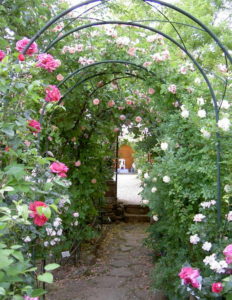
The beautiful Abbey park, garden and nursery are an absolute delight to spend some time wandering through. Along each terrace of land, you can stroll through the floral spaces rich with a thousand spring bulbs, and 550 varieties of roses, intermingled with other flowering plants and shrubs. There is an annual event, “Abbaye en Roses” celebrating the full bloom of the roses that runs from the end of May to the beginning of June.
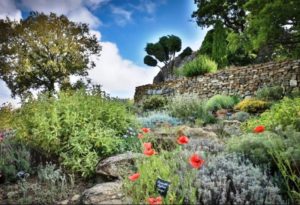
The “dry garden” opened in 2013, with 350 plant varieties growing on arid land, and of course, 35 varieties of lavender and a small olive grove. It goes without saying that this remarkable garden employs only 100% natural practices for homeopathy, aromatherapy, mulching with local lavender straw etc.
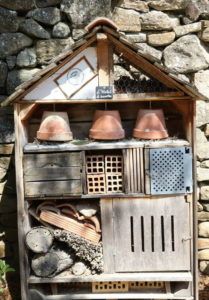
You will also pass by specially constructed, individual “hotels” for ladybirds, butterflies and lacewings, as well as birds’ nesting boxes, a hedgehog’s den, a badger’s passage, the fluid “vortex” that dynamises the water, while the gentle melody of wind chimes floats on the breeze. The Abbey describes itself as an “agro-ecological” garden, and offers a free 32 page practical guide to all visitors with a wealth of information about the garden, its plants, the local fauna, the maintenance practices and related topics. The garden covers an area of approx. 8,000 sq.m. A must-visit for all garden lovers.
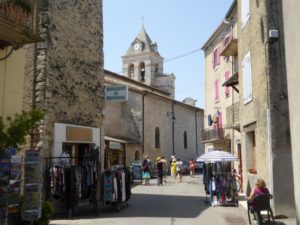
Most visitors to Provence concentrate their explorations to the splendid headline sites of the Luberon area such as Gordes, Roussillon, Bonnieux, Ménerbes and perhaps Lourmarin. But if you spread your tourist wings a little further afield, you will discover that there are many relatively unknown gems in the Haute Provence. Simiane-la-Rotonde and the Abbaye de Valsaintes and its beautiful gardens are just two of them. We’ll look at other very rewarding attractions in the region another time.
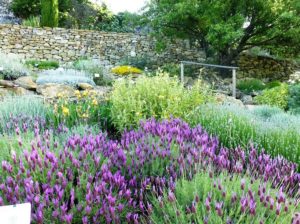


Leave a Reply